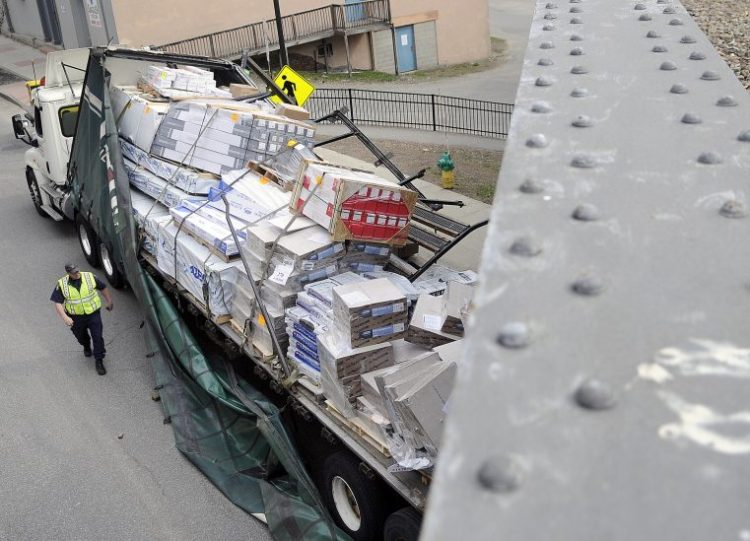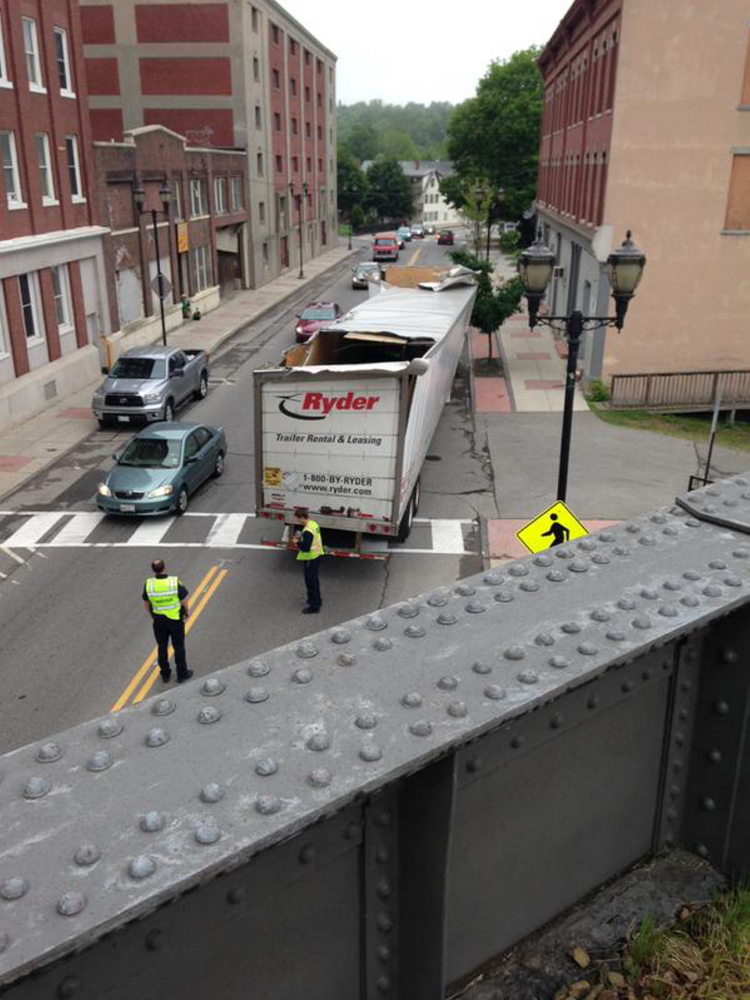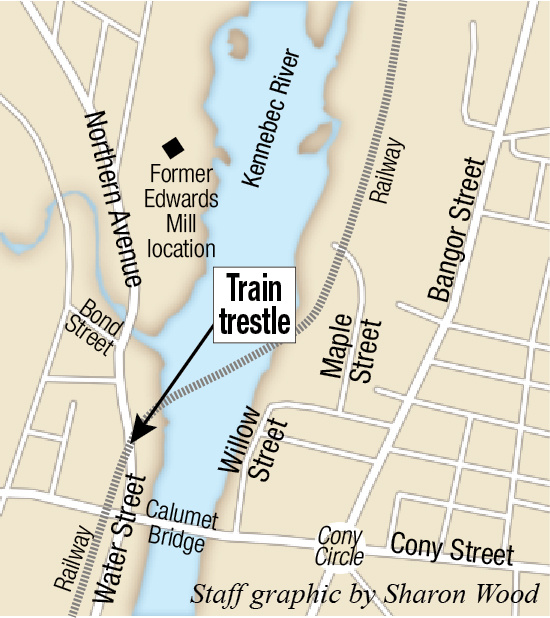AUGUSTA — The state Department of Transportation is designing a system of sensors and flashing lights to warn the drivers of tall trucks not to try to drive under a railroad trestle on Water Street that has taken out so many big rigs over the years it has its own nickname, the “can opener.”
The proposed $45,000 system would use sensors that would be installed on Water Street on both approaches to the train overpass in the city’s downtown. The sensors would detect when a truck too tall to fit under the bridge passes by them, which in turn would trigger a warning system of flashing lights mounted, alongside warning signs, on the approach to the trestle.
The system is in the design stages and transportation officials hope to have it installed in the spring of 2018.
Police have to respond regularly to the area, either for a truck that has struck the bridge, or to at least help a truck driver back up or turn around after they stop before going under it, but after they’ve passed any other good options to get around it.
Since January of 2016, Augusta police have responded to 23 non-accident complaints at the site, often to assist trucks in backing up or turning around without actually going under the bridge, and three actual accidents.
“It seems to be less than there used to be; there used to be trucks opening up (after striking the bridge) all the time, but obviously it is still a problem. We go down there on a regular basis,” said Deputy Police Chief Jared Mills. “Anything is going to help.”
There already are warning signs on both approaches, and on the bridge itself, advising it is only 12 feet, 10 inches tall, but drivers of trucks taller than that still apparently miss those signs and try to drive under the bridge. Sometimes they hit it or, sometimes they strike the bridge but keep going, which in some cases has peeled the tops off of trailers like a sardine can lid, likely giving the trestle its informal local name.
“There are some pretty brilliant signs there now, which work to some degree, but not enough,” said Aurele Gorneau, project manager on the job for the state transportation department. He said the current signs don’t have flashing lights. He hopes the flashing lights, activated only when a truck sets off the sensors, will be more eye-catching and garner drivers’ attention.
“There are signs but, unfortunately, I think there are still a lot of GPS (systems) that take trucks there,” Mills said. “We ask the out-of-state truckers why they came that way and they say ‘That’s where my GPS brought me.’ They’re not paying attention to the signs. It’s well-signed. It’s just a matter of not reading the signs and not paying attention.”
With space tight and intersections near both sides of the railroad trestle, the proposed new warning system won’t give much warning to truck drivers until they’re close to the trestle, and thus may not prevent the need for police to respond to help vehicles turn around or back out if they stop after seeing the warnings but before going under the bridge.
Gorneau said on the northern side, the sensors will be near the Bond Street intersection, and the warning lights close to the Laurel Street intersection.
On the southern end, the sensors will be near the intersection with Bridge Street, and the warning lights near the end of the block of buildings shortly before the railroad trestle.
“We don’t have a lot of space down there on Water Street,” Gorneau said. “It will be a challenge, getting them back far enough,” to provide advanced warning.
Mills noted even a short warning distance is better than none. He said it only takes maybe a few minutes to help a truck turn around, versus an hour or more to investigate an accident and remain on scene as an accident site is cleaned up.
A similarly low railroad bridge over Route 24 in Richmond was removed earlier this year from a currently unused rail line. That bridge had been struck and damaged and would not have been able to handle train traffic without first being repaired, according to Jeff Pitcher, a Department of Transportation transportation manager and Federal Railway Administration track safety inspector for Maine. Ted Talbot, spokesman for the state transportation department, said the Richmond bridge could be replaced if rail service returns to the line.
The Richmond and Augusta bridges are on the same rail line, which is unused.
Nathan Moulton, director of the state Office of Freight and Business Services, said the state purchased the rail line under the Rail Preservation Act for future rail use. He said removing the bridge in Augusta would require the state to build a new one in the future, if trains return, at a significant cost.
City Engineer Lionel Cayer said in his view the state could jack up the section of trestle, place it on blocks so it would sit higher, and out of the way of passing trucks but could, if trains return, be lowered back down.
But, as Mills noted, it’s the state’s railroad bridge, so the city must defer to the state’s plans for it.
The project still needs to go through environmental and historic preservation reviews, and final design, before it could be built.
Gorneau said a similar system is in use in Bangor.
Talbot said the project seeks to take advantage of improving technology to prevent trucks from striking the bridge.
“The fact is this bridge still keeps getting hit even though we’ve got signs up there now, so we’re trying to find something more effective to try to mitigate accidents,” he said. “This is for driver protection, to avoid property damage, and cut down on any damage to state inventory.”
Gorneau and Mills said despite the number of times the bridge has been hit, it doesn’t appear to have sustained structural damage.
Officials have previously looked into lowering the road under the bridge, but Cayer said, in 2012, that was projected to cost about $150,000.
Mills said truck drivers who strike the bridge sometimes get a ticket from city police, but sometimes they don’t. He noted State Police commercial vehicle unit officers respond to accidents involving trucks, so the drivers may be subject to potential fines from them.
Plus, hitting a sturdy, heavy metal bridge tends to make a lasting impression.
“In my time here, 19 years, we haven’t had somebody do it twice,” Mills said of trucks striking the bridge.
Keith Edwards — 621-5647
Twitter: @kedwardskj
Send questions/comments to the editors.






Comments are no longer available on this story